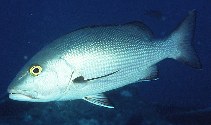| Family: |
Lutjanidae (Snappers), subfamily: Lutjaninae |
| Max. size: |
90 cm TL (male/unsexed); max.weight: 13 kg; max. reported age: 55 years |
| Environment: |
reef-associated; freshwater; brackish; marine; depth range 0 - 180 m |
| Distribution: |
Indo-Pacific: East Africa to the Marquesas and Line islands, north to the Ryukyu Islands, south to Australia. More common around oceanic islands than in continental areas. |
| Diagnosis: |
Dorsal spines (total): 10-10; Dorsal soft rays (total): 13-14; Anal spines: 3-3; Anal soft rays: 8-8. This species is distinguished by the following characters: moderately deep body, its greatest depth 2.4-2.9 in SL; distinct groove or pit from nostrils to the front of the eye; preopercular notch and knob moderately developed; vomerine tooth patch narrow crescentic, without a medial posterior extension; gill rakers of first gill arch 6-7 + 16 = 22-23 (including rudiments). Colour of body dark reddish-brown with faint dark stripes; young and some adults with two silvery-white spots on back; pectoral fins pink with dorsal edge prominently black; juveniles sometimes have caudal end of body and the tail white. mimicking Chromis damselfishes (Ref. 9821, 90102).
Description: Snout somewhat pointed; head dorsal profile rounded; preorbital bone broad, width usually greater than eye diameter; scale rows on back rising obliquely above lateral line (Ref. 9821). |
| Biology: |
Adults inhabit coral reefs, including sheltered lagoons and outer reefs (Ref. 30573). Usually found singly, often adjacent to steep outer reef slopes, but occasionally found in groups (Ref. 9710). Feeds mainly on fishes, but also take shrimps, crabs, amphipods, stomatopods, gastropods and urochordates. Large fish from oceanic areas in the western Pacific are often ciguatoxic, e.g., in Tuvalu (Ref. 9513). Caught mainly with handlines and bottom longlines (Ref. 9821). Utilized fresh and dried-salted (Ref. 9987). Juveniles mimic Chromis damselfishes (Ref. 90102). Minimum depth reported taken from Ref. 128797. |
| IUCN Red List Status: |
Least Concern (LC); Date assessed: 04 March 2015 Ref. (130435)
|
| Threat to humans: |
reports of ciguatera poisoning |
Source and more info: www.fishbase.org. For personal, classroom, and other internal use only. Not for publication.

